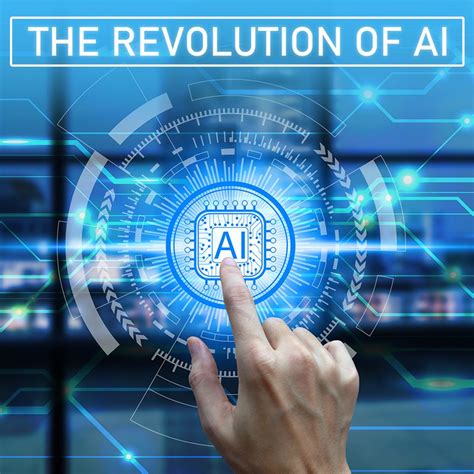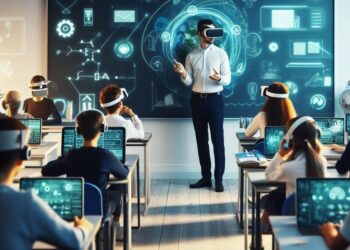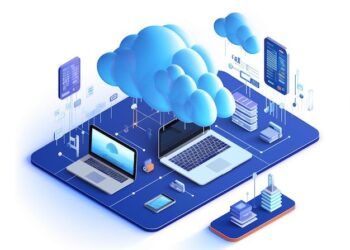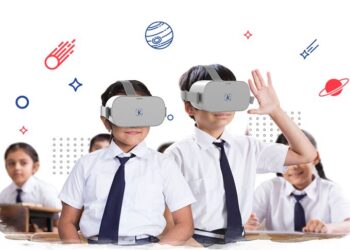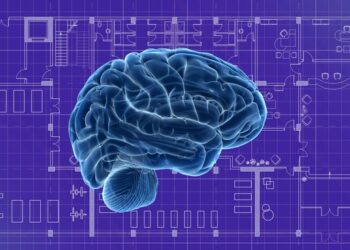The hallowed halls of education, for centuries defined by blackboards, textbooks, and a one-to-many teaching model, are standing on the precipice of their most significant transformation. A quiet but powerful revolution is underway, driven not by new pedagogical theories alone, but by the pervasive and intelligent force of Artificial Intelligence (AI). This is not a futuristic fantasy; it is the present reality reshaping how students learn, how educators teach, and how institutions operate. AI in education is far more than a novel tool; it represents a fundamental paradigm shift, moving us from a standardized, industrial-age model to one that is deeply personalized, remarkably efficient, and infinitely adaptable.
For generations, the classroom has operated on a principle of averages. A single teacher, faced with thirty unique minds, must deliver a curriculum designed for a hypothetical “average” student. The inevitable result is a spectrum of disengagement: some students are left behind, struggling to grasp concepts, while others are bored, waiting for the class to catch up to their advanced understanding. This one-size-fits-all approach is a compromise born of necessity, not of ideal design. AI shatters this compromise. By leveraging the power of data and sophisticated algorithms, AI offers the tantalizing promise of providing a unique, tailored educational journey for every single learner on the planet.
This in-depth exploration will unpack the multifaceted impact of the AI revolution on education. We will journey through the world of hyper-personalized learning paths, discover how AI is becoming an indispensable ally for teachers by liberating them from administrative drudgery, and examine the profound changes AI is bringing to the very structure of educational institutions. Furthermore, we will critically analyze the ethical hurdles and challenges that must be navigated to ensure this technological leap forward benefits all of humanity. Welcome to the new era of learning.
The Dawn of Personalized Learning at Scale
The core promise of AI in education is its ability to deliver on a long-held dream: a truly personalized learning experience for every student. This isn’t just about changing the color of a user interface; it’s about dynamically altering the very fabric of the curriculum in real-time to match an individual’s unique needs, pace, and style of learning. This student-centric revolution is unfolding through several key technologies.
A. Adaptive Learning Platforms Imagine a digital textbook that rewrites itself for every reader. That is the essence of an adaptive learning platform. These sophisticated systems use AI to continuously assess a student’s performance and understanding as they interact with the material. If a student answers a question about algebraic fractions incorrectly, the platform doesn’t just mark it wrong; it recognizes a potential gap in foundational knowledge. It might then present a brief video tutorial on the basics of fractions, followed by a series of simpler practice problems, before re-introducing the more complex concept. Conversely, if a student is acing every question, the system will accelerate the pace, introducing more challenging material to keep them stimulated and engaged. This dynamic adjustment ensures that learners are always operating in their “zone of proximal development”—the sweet spot where material is challenging but not overwhelmingly difficult.
B. Intelligent Tutoring Systems (ITS) One of the most powerful learning tools is one-on-one tutoring, a luxury historically available only to the affluent. Intelligent Tutoring Systems are democratizing this advantage. An ITS is an AI-powered program designed to simulate the behavior of a human tutor. It can provide step-by-step guidance on complex problems, offer hints instead of direct answers, and provide instant, granular feedback. For a student struggling with a physics equation at 10 PM, an ITS can be an invaluable resource, available on-demand to break down the problem and explain the underlying principles. These systems build a profile of the student’s knowledge over time, allowing them to target weaknesses with surgical precision and reinforce strengths, creating a robust and comprehensive understanding of the subject matter.
C. AI-Curated Content and Customized Pathways The modern student has access to a near-infinite amount of information. The challenge is navigating it. AI is becoming a master curator, capable of assembling personalized learning pathways from a vast repository of content. By analyzing a student’s learning history, stated interests, and future career goals, an AI engine can recommend the perfect blend of reading materials, video lectures, podcasts, and interactive simulations. For a student who learns visually and is interested in marine biology, the AI might construct a curriculum heavy on documentaries and virtual underwater labs, while a kinesthetic learner interested in engineering might be guided towards interactive 3D modeling projects. This moves beyond a static curriculum to create a living, breathing educational journey that resonates with each student’s passions and learning preferences.
Empowering Educators: AI as the Ultimate Teacher’s Assistant
A common fear surrounding AI is that it will render human professions obsolete. In education, however, the most likely and beneficial outcome is not replacement, but augmentation. AI is poised to become the ultimate teacher’s assistant, a powerful ally that handles the monotonous and time-consuming aspects of the job, thereby freeing up educators to focus on what they do best: inspiring, mentoring, and connecting with their students on a human level.
A. The End of Administrative Monotony Teachers consistently report that an enormous portion of their time is consumed by administrative tasks that have little to do with actual teaching. Grading papers, taking attendance, scheduling parent-teacher conferences, and filing paperwork are relentless drains on their energy and passion. AI is a game-changer in this domain. AI-powered tools can instantly grade multiple-choice and fill-in-the-blank assessments with perfect accuracy. More advanced AI can even grade essays and short-answer questions, checking for grammar, syntax, and conceptual understanding against a predefined rubric. By automating these burdensome tasks, AI gives teachers back their most valuable resource: time. This reclaimed time can be reinvested into one-on-one student interaction, creative lesson planning, and professional development.
B. Unlocking Data-Driven Insights for Early Intervention Every student generates a trail of data through their interactions with educational software. AI excels at analyzing these vast datasets to uncover patterns that would be invisible to the human eye. An AI-powered dashboard can provide a teacher with a holistic view of their classroom’s progress at a glance. It can flag not just individual students who are beginning to fall behind, but also specific concepts that the entire class is struggling to grasp. For instance, if 70% of students perform poorly on a quiz section about cellular mitosis, the AI can alert the teacher immediately. This allows for timely and targeted intervention. The teacher can then re-evaluate their teaching method for that specific topic, provide supplementary materials, or organize small group sessions, addressing the problem before it snowballs into a significant knowledge gap.
C. A Collaborative Partner in Curriculum Design Lesson planning is a highly creative but also time-intensive process. AI tools are emerging as powerful collaborative partners for educators. A teacher can input a learning objective—for example, “teach the causes of the American Revolution to tenth graders”—and an AI assistant can instantly generate a wealth of resources. It can suggest engaging video clips, link to primary source documents from online archives, create sample quiz questions, and even design project-based learning activities tailored to different learning styles. This doesn’t replace the teacher’s professional judgment; it supercharges it. The teacher remains the expert who curates and delivers the lesson, but with AI handling the heavy lifting of resource discovery and initial content creation.
System-Wide Transformation: The Institutional Impact of AI
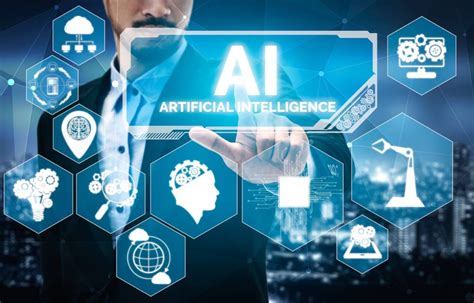
The AI revolution extends far beyond the individual classroom, promising to reshape the operational and strategic landscape of entire educational institutions. From admissions to resource allocation, AI is introducing a new level of intelligence and efficiency to the business of education.
A. Intelligent and Equitable Admissions The university admissions process is a monumental task, involving the review of thousands of applications, each with numerous data points. AI is being used to streamline this process, helping admissions officers manage the deluge of information more effectively. AI algorithms can perform initial screenings, verifying application completeness and flagging candidates who meet specific criteria. Furthermore, AI-powered chatbots can be deployed on university websites to act as 24/7 recruitment assistants, instantly answering prospective students’ questions about courses, campus life, and financial aid, thereby improving the applicant experience and freeing up human staff for more complex inquiries.
B. Optimized Resource and Campus Management Running a school or university is like managing a small city. AI can bring significant optimization to this complex endeavor. AI algorithms can analyze historical enrollment data and student preferences to create highly efficient class schedules that minimize conflicts and optimize classroom utilization. On a broader scale, AI can assist in campus resource management, from predicting energy consumption in different buildings to optimizing bus routes. Some institutions are even using predictive analytics to identify students at high risk of dropping out. By analyzing factors like class attendance, grade trends, and engagement with online resources, the system can alert counselors to intervene with support and guidance, boosting student retention rates.
Navigating the Ethical Maze: Challenges on the AI Horizon
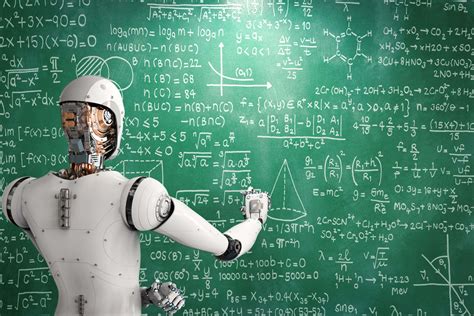
The transformative potential of AI in education is immense, but it is not without its perils. As we integrate these powerful tools into the fabric of learning, we must proceed with caution and a strong ethical compass, addressing several critical challenges head-on.
A. Data Privacy and Security Educational AI systems run on data—vast amounts of sensitive student data. This includes academic performance, learning behaviors, and personal information. Ensuring the security and privacy of this data is paramount. We must establish robust regulations and technical safeguards to prevent data breaches and misuse, ensuring that student information is used solely for the purpose of improving their educational outcomes.
B. The Specter of Algorithmic Bias AI systems learn from the data they are trained on. If this historical data contains hidden biases—and it almost certainly does—the AI can learn and even amplify those biases. An AI model trained on biased data might incorrectly conclude that students from certain socioeconomic backgrounds are less likely to succeed in STEM fields, potentially limiting their educational opportunities. It is crucial to rigorously audit AI algorithms for bias and ensure they are promoting equity, not reinforcing historical inequalities.
C. Bridging the Digital Divide The benefits of the AI revolution in education must be accessible to all, not just a privileged few. There is a significant risk that the schools and students with the most resources will have access to the best AI tools, while those in underserved communities fall even further behind. Ensuring equitable access to the necessary hardware, high-speed internet, and high-quality AI software is a societal challenge that must be addressed through public policy and investment.
In conclusion, the integration of Artificial Intelligence into education is the most profound shift in learning since the invention of the printing press. It promises a future where every student can learn at their own pace, following a path uniquely tailored to their strengths and passions. It offers educators the chance to be mentors and inspirers, freed from the shackles of repetitive administrative work. However, realizing this bright future requires careful navigation of the associated ethical challenges. If we can successfully balance innovation with responsibility, AI will not replace the human element of education; it will elevate it, unlocking a new world of human potential and creating a smarter, more equitable, and more engaging future for learners everywhere.

